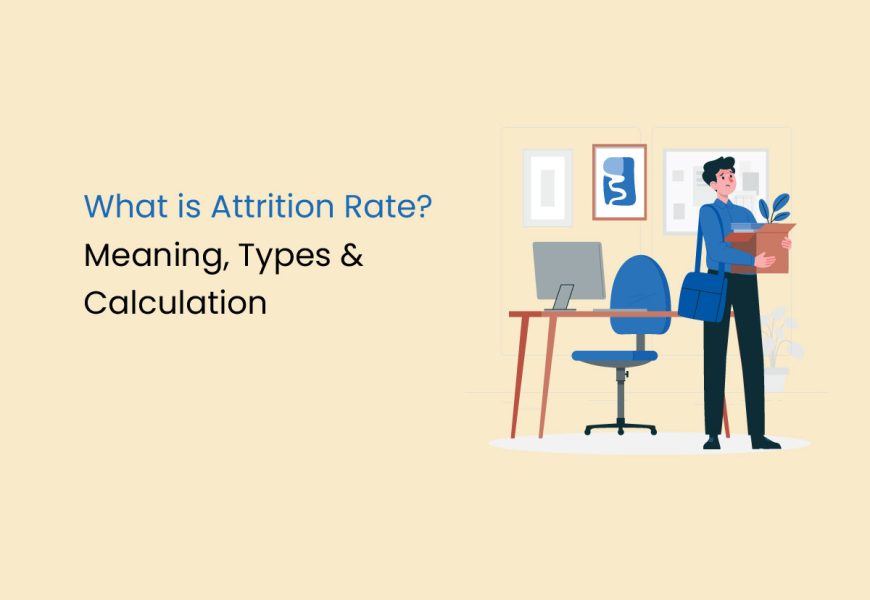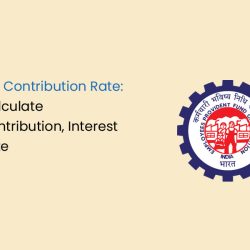The attrition rate is an important metric that helps an organisation gain insight into the workforce’s stability and satisfaction. It assesses the effectiveness of the organisation’s retention strategies and identifies potential areas for improvement in workforce planning, employee management, and engagement.
Let’s learn more about attrition rate–its meaning, types, and how to calculate it.
What is the Attrition Rate?
The attrition rate is a measure that calculates the frequency at which employees leave a company, whether due to retirement or resignation, without being immediately replaced over a specific period. It is usually expressed as a percentage which indicates the speed at which workers are being replaced. Tracking attrition rate helps HR monitor if the number of staff leaving is growing or declining and improves workforce planning and management.
The reasons why employee attrition takes place are as follows:
- Unsatisfactory pay or benefits
- Lack of opportunity
- Poor workplace conditions
- Poor work-life balance
- Illness and death
- Retirement
- Relocation
Types of Attrition
The following are the types of attrition:
Voluntary Attrition
Voluntary attrition occurs when an employee chooses to leave the organisation. The voluntary departure of employees could signify issues within the company. Still, it could also stem from personal reasons unrelated to the organisation’s operations.
Voluntary attrition can also occur due to employee retirement. Unless a company faces an exceptionally high frequency of early retirements, employees retiring should not raise management concerns.
Involuntary Attrition
Involuntary attrition arises when a business terminates employees, typically due to poor or disruptive performance, misconduct, or the need to eliminate positions or conduct layoffs amid challenging economic conditions.
Internal Attrition
Internal attrition is when employees move from one department or division to another within a company. It may happen when an employee is promoted or shifts to a different section for a better-suited job. High internal attrition can show good career growth opportunities. Still, if a department has a high rate, it indicates that there are underlying issues that must be addressed.
Demographic-Related Attrition
Demographic-related attrition occurs when people from specific groups, like women, minorities, veterans, older workers, or individuals with disabilities, leave a company suddenly. This could signal workplace harassment or discrimination, affecting the overall environment and business success. Companies must investigate promptly and address the root causes to prioritise inclusion. This fosters diversity, retains valuable employees, and prevents future attrition. Diversity training is key in addressing and preventing such issues.
Customer Attrition
Customer attrition occurs when a company’s customer base declines, often measured by the churn rate. This decline can signal potential trouble for the company and result in revenue loss. Therefore, it’s essential for businesses to actively track and address customer attrition to maintain a healthy customer base and sustain revenue streams.
Customer attrition can take place for the following reasons:
- Loyal customers switch their preference to another company
- Younger customers aren’t replacing ageing ones
- Bad customer service
- Changes in product lines
- Failure to update product lines
- Poor product quality
Factors Impacting Attrition Rate
The following factors affect the attrition rate:
Internal factors
The internal factors are as follows;
- Compensation: Employees may seek opportunities elsewhere if they feel they are given inadequate compensation for their contributions. They may opt for a company offering higher compensation, even if both provide similar responsibilities and job titles. Compensation also encompasses additional financial incentives such as bonuses, commissions, and annual raises.
- Job Satisfaction: Employees spend a substantial portion of their lives at work, emphasising the importance of job satisfaction. Employees are more inclined to seek opportunities elsewhere when employers overlook recognising and rewarding good performance or impose overly restrictive work environments, such as inflexible schedules.
- Learning and Development: Employees are more likely to leave if they feel their career progression is limited or are not provided with opportunities for skill development and advancement.
- Work Environment: A negative workplace culture due to harassment, discrimination, or lack of support can drive employees away.
- Leadership: Poor leadership, lack of communication, and a failure to engage and motivate employees can also contribute to attribution.
External Factors
- Workforce Demographics: To address an impending wave of retirements, companies should proactively redistribute responsibilities among existing team members to maintain continuity. If certain positions become obsolete, waiting for senior employees to retire before eliminating those roles can save on retraining or severance costs.
- Industry Shifts: Any changes in the business landscape can affect staffing requirements. For instance, as brick-and-mortar stores decline, the need for retail staff decreases. Conversely, the ongoing expansion of e-commerce requires more individuals for online and logistics support roles.
- Economic Conditions: During economic growth, companies can hire more and offer better salaries and perks to retain top talent. Conversely, during a recession, reduced consumer spending impacts businesses, leading to salary cuts and reduced hiring.
How to Calculate Attrition Rate
The formula to calculate is as follows:
Attrition Rate = (Number of Departures / Average Number of Employees) x 100
To find the average number of employees, add the number of employees at the start and the end of the specified period divided by 2.
Example: Say that 75 employees left XYZ Company last year. In addition, the company had an average of 500 employees for the year.
You can calculate the attrition rate by:
Attrition Rate = 75/500 x 100
Attrition rate = 0.15 x 100
Attrition rate = 15%
What is a High Attrition Rate?
It’s important to remember not to analyse the attrition rate in isolation. It must be considered within the broader context of what is happening in the industry, region, and world.
Based on averages, an attrition rate of over 20% can be considered high. However, this can vary significantly across industries. Therefore, conducting more specific research to see how an organisation’s attrition rate compares to similar companies is essential. As a general guideline, if the organisation’s rate exceeds 20% in any year, it indicates that there should be an investigation to identify any underlying issues and explore ways to improve.
Is 0% Attrition Rate Good?
At first glance, a 0% attrition rate may be the perfect scenario for any organisation as it indicates that all employees are staying. However, the truth is more complex. Although a low attrition rate can be a positive sign for a company, having a 0% rate can also have some disadvantages. Some of these disadvantages are as follows:
- Stagnation and Lack of Fresh Ideas: Companies should regularly hire new employees instead of relying on the same workers. New hires can bring new perspectives, diverse experiences, and innovative ideas that can help the company grow and adapt better. Although stability is important, new employees’ energy and fresh ideas can significantly benefit the company.
- Possible Signs of Complacency: Companies benefit from having employees who stay with them long. However, if there is no turnover, it could be a red flag. It may suggest that employees are not leaving because they are happy and passionate about their work but because they lack the motivation to seek better opportunities elsewhere. Therefore, companies must differentiate between loyal employees who are fully committed and content with the current situation.
- Natural Career Progression: It is common for employees to leave organisations due to personal reasons or to pursue better career opportunities. Some attrition is natural and can be seen as a positive sign that employees seek growth and development, even if that means moving on to other opportunities.
- Potential Overlook of Internal Issues: A 0% attrition rate may cause companies to overlook potential internal issues, leading them to believe everything is perfect. To ensure a genuinely engaged and content workforce, it’s crucial to continually assess employee satisfaction and organisational health, regardless of attrition rates.
Importance of Attrition Rate
Attrition rate matters for the following reasons:
- Financial Costs: High attrition rates often lead to substantial recruitment and training expenses. Finding replacements and bringing them up to speed can be time-consuming and costly. It’s estimated that the total cost of recruiting and training a new employee can amount to as much as twice their salary.
- Decrease in Productivity: An employee’s departure can disrupt workflow and result in the loss of valuable accumulated knowledge, impacting team dynamics and overall productivity until a replacement is recruited and properly trained.
- Employee Morale: High attrition rates can harm workforce morale, as they may question the stability and culture of the company. This uncertainty can prompt them to explore alternative employment opportunities.
- Talent Loss: Attrition can lead to the departure of skilled and experienced employees, ultimately eroding the company’s competitive edge. The long-term impact can harm the company’s success if valuable talent continues to migrate to competitors or other industries.
- Insight into Workplace Issues: An increasing attrition rate can signal underlying organisational issues. By tracking this metric, businesses can pinpoint and tackle problems related to workplace culture, management practices, or employee dissatisfaction.
- Impact on Organisation Reputation: High employee turnover can harm an organisation’s reputation and employer value proposition, making it harder to attract top talent. Prospective employees may see frequent departures as a sign of internal issues or limited growth opportunities.
- Customer Service and Satisfaction: Frequent turnover in client-facing positions can affect the quality of service delivered to customers. Consistency in client relationships is crucial for fostering trust and ensuring satisfaction.
Attrition vs Turnover
Attrition is when employees leave faster than they can be replaced, causing extended vacancies or position eliminations due to skill shortages. It’s a long-term issue with positive and negative impacts, requiring business and HR strategies for resolution.
Turnover involves new hires replacing departing employees, indicating short-term changes. High turnover is costly due to hiring and training expenses, leading to a loss of institutional knowledge and stifling creativity and innovation.
Attrition vs Retention
The retention rate is the percentage of employees employed by a company during a specific period. Conversely, attrition metrics measure the percentage of employees who leave the company. However, relying solely on the retention rate doesn’t give a complete view of the organisation’s health. We must dig deeper into retention data, including turnover and attrition, to understand it better. Attrition helps to understand the impact of employee departures on the organisation’s strength. Thus, it is a crucial metric to consider alongside retention.
How to Conduct an Attrition Analysis
You can conduct an employee attrition analysis by following these steps:
- Gather Headcount data and Calculate the Attrition Rate: Access headcount data from HRIS or personnel records and apply the attrition rate formula to determine the current rate. If you want to compare it with previous periods, gather historical data.
- Look for Signs of High Attrition Rate: To determine if your attrition rate is unusually high, compare it to industry benchmarks, past rates, or internal targets. Look for patterns and trends, such as sudden departure increases or consistently high attrition in specific departments or roles. Understanding these patterns can help identify potential organisational issues contributing to high attrition.
- Identify Risk Factors for Employee Attrition: Signs of high attrition risk in a company include declining employee engagement, increased absenteeism, high turnover in specific departments, difficulty filling vacant roles, and increased retirement rates.
- Use Additional Metrics to Track Attrition: To gain a better understanding of your workforce, consider tracking and analysing HR metrics such as employee retention rate, performance metrics, eNPS, and exit interview data in addition to attrition rate. These metrics can help detect potential issues that lead to increased employee turnover.
- Compile a Report and Prepare a Plan of Action: Consolidate all data, identify attrition trends and highlight areas of concern. Use visual aids and interpretation to make the findings accessible. Develop an actionable plan to reduce attrition and improve workforce management with clear objectives, timelines, and responsibilities.
Strategies to Reduce Attrition Rate
Some HR strategies helpful in reducing attrition rates are as follows:
- Prioritise Employee Well-being: Employee well-being is crucial for a thriving workplace. When employees feel their best, they perform at their peak, staying engaged and loyal to their employers.
- Foster Employee Engagement: Engaged employees stay longer. To boost engagement, offer meaningful work, recognise achievements, promote belonging, provide feedback, and do team-building activities.
- Invest in Learning and Development: Offering diverse learning and training programs demonstrates the company’s commitment to employee growth and potential advancement, fostering retention by showcasing personal and professional development opportunities.
- Implement Cross-Training Initiatives: Cross-training equips employees with versatile skills to fulfil multiple roles, enhancing workforce flexibility and ensuring operational continuity. It reduces the urgency to fill vacancies immediately, allowing for a more strategic recruitment process.
- Develop Succession Plans: Anticipating and preparing for employee departures, including retirements, minimises disruption and retains institutional knowledge. Succession planning identifies potential retirees in advance and trains other employees to assume their roles, ensuring a smooth transition.
- Provide Competitive Compensation and Benefits: Salary is a significant factor in the employee-employer relationship. A competitive compensation package is essential for attracting and retaining top talent, preventing prized employees from seeking opportunities elsewhere.
- Promote Work-Life Balance: A healthy work-life balance enables employees to enjoy their professional and personal lives, leading to greater satisfaction and reduced turnover.
- Implement Effective Leadership: Effective leadership is crucial for employee satisfaction and retention. Training managers to motivate, guide, and support their teams can significantly reduce dissatisfaction and attrition.
- Regularly Conduct Exit Interviews: Exit interviews are valuable to understand why employees leave. Addressing underlying issues and preemptively tackling problems can prevent future attrition.
Conclusion
Employee attrition is a multifaceted problem that can seriously affect organisations of all sizes and industries. By identifying the factors contributing to attrition, implementing effective strategies to manage it, and prioritising employee retention, organisations can create a stable, engaged, and productive workforce conducive to long-term success and growth.
Frequently Asked Questions
What does a 20% attrition rate mean?
An attrition rate of 20% refers to the percentage of an organisation's workforce that has left during a given period, usually a year, without being immediately replaced. The degree to which a 20% attrition rate is considered high depends on the specific industry, the job's nature, and the organisation's usual practices.
Can you have an attrition rate over 100%?
An attrition rate over 100% implies that more employees left than the total number present at the start of the period without immediate replacement. An employee turnover rate over 100% means that the number of employees leaving and being replaced during a specific period exceeds the average total number of employees. This typically happens in high-turnover industries like retail, hospitality, or customer service.
How is employee attrition different from customer attrition?
Employee attrition occurs when workers leave and aren't replaced, while customer attrition is a decline in the customer base.
Is attrition good or bad?
Employee turnover can be a challenge for corporations as it can result in the loss of valuable talent. However, it can also prompt companies to identify underlying issues and reduce labour costs by not replacing departing employees. Eventually, this can lead to recruiting new employees with fresh energy and innovative ideas.
How can I stop customer attrition?
To prevent customer attrition, you must ensure that your company offers the products and services your customers seek. Additionally, providing excellent customer service, staying up-to-date with market trends, and promptly addressing any issues arising from customer complaints can significantly help retain your customers.
What is attrition in BPO?
Attrition rate in BPO is the percentage of employees who leave an organisation during a specific period. This rate significantly impacts the stability, productivity, and performance of a BPO.


























